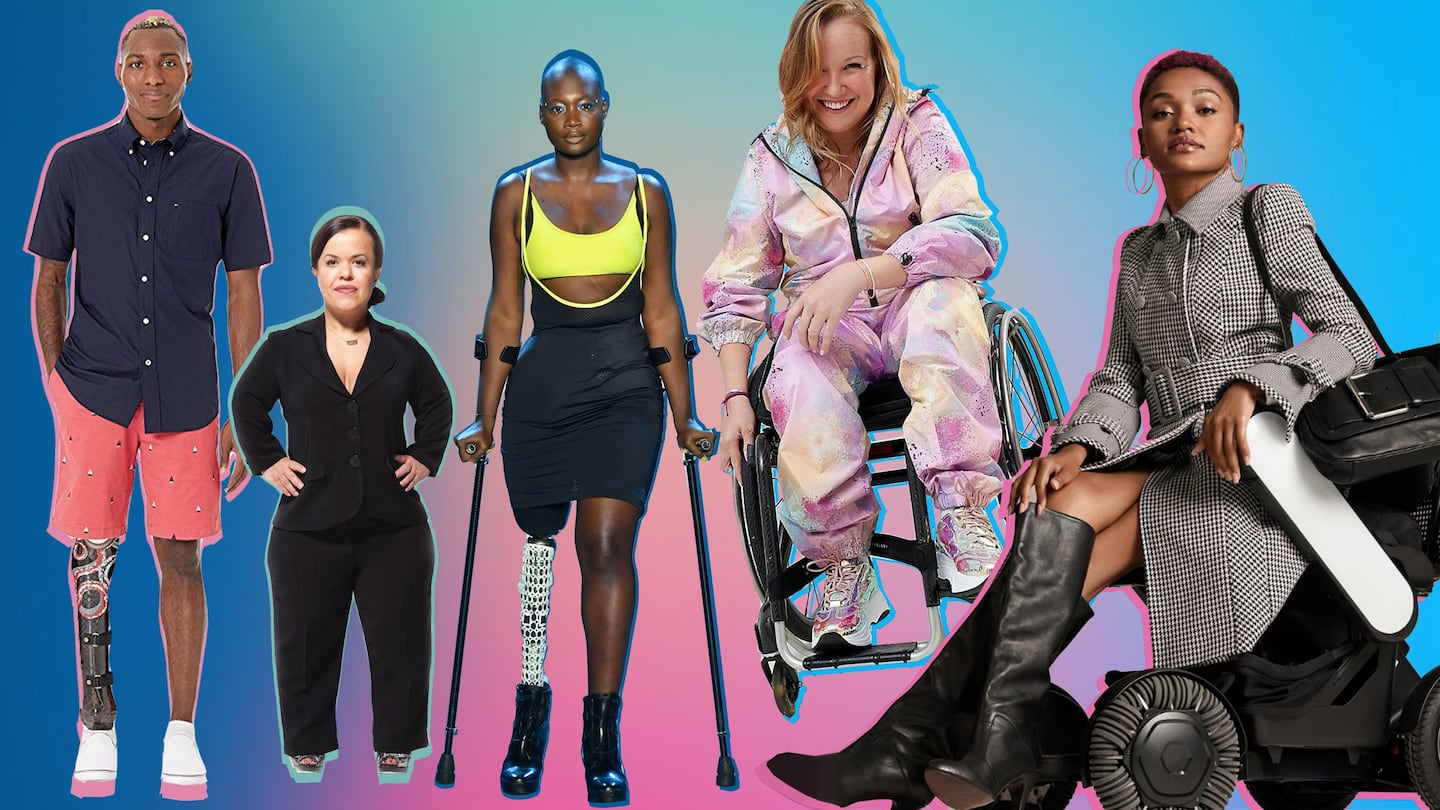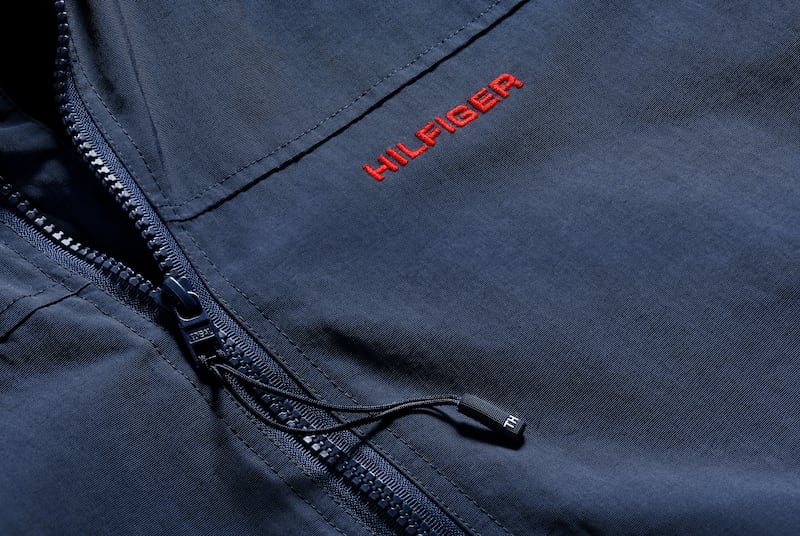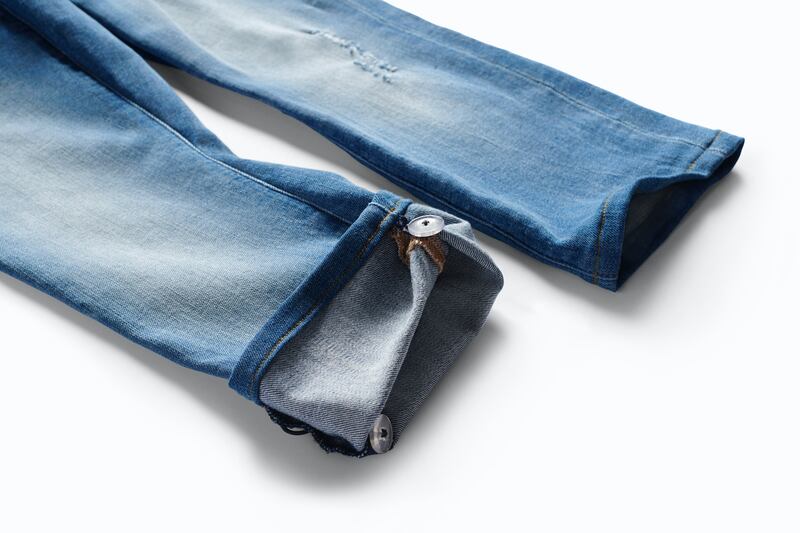
The Business of Fashion
Agenda-setting intelligence, analysis and advice for the global fashion community.

Agenda-setting intelligence, analysis and advice for the global fashion community.

NEW YORK, United States — As a teenager growing up in Columbus, Ohio, Chelsea Funk used to buy old materials from thrift stores and sew her own clothes.
She didn't have much choice. Funk, now 23, was born with amniotic band syndrome and only has a portion of her left arm. While her favourite brands included Kate Spade and Stella McCartney, Funk found it easier to experiment with her own designs than fork over money for expensive pieces that required extra work.
"Buttons and zippers were always hard, and the worst was buying regular clothes and then having to deal with half a foot of dead fabric hanging off my arm, or rolled up and feel extremely uncomfortable," she says.
After studying at Columbus College of Art and Design, Funk started her own fashion line, Pit and Pug. She makes custom clothes for children with disabilities — replacing rigid denim seams with zips and creating polo shirts with magnet closures. She's also debuting outerwear for adults this autumn. Funk finds her work meaningful because it's serving a population she can relate
to, but she says the business opportunity is exciting too.
ADVERTISEMENT
“Unfortunately, the disabled community has been looked at as lesser human beings, but just because someone’s body is different does not mean they want to wear dresses that look like hospital gowns,” she says. “There are millions of people out there who want to buy clothes that properly fit them.”
Funk joins a rising class of designers who are making adaptive fashion, specialised clothes altered to cater to the needs of people with disabilities. With big companies such as Target, Kohl's, Zappos and Tommy Hilfiger jumping in alongside independent designers like Funk, the category is poised for major growth.
The Adaptive Fashion Opportunity
Approximately one in every four adults in the US — about 26 percent of the population — lives with a disability, according to the Centers for Disease Control and Prevention. The UK has about 13.3 million adults who have a disability, almost one in five of the population, according to the Disabled Living Foundation.
There are millions of people out there who want to buy clothes that properly fit them.
The demand for clothes to adapt for special needs is real. The solution can be as simple as using magnetic buttons and other types of easy-access fixtures, but the category can wade into more challenging territory, like reconfiguring silhouettes entirely so they are accessible for wheelchair users.
The needs of the disabled population have long been ignored by fashion, says Kerri McBee-Black, a professor at the University of Missouri who studies clothing and disabilities.
“There was a lot of interest in figuring out design developments in the ’60s, but there was no relationship between that research to fashion or style because the business wasn’t seen as viable,” says McBee-Black. “It was seen as a costly endeavour, and there was an association that a majority of people with disabilities are low-income and don’t care about fashion.”
This attitude is changing. Social media has given people with disabilities a platform to share their experiences and become more visible. Inclusivity has also become a hot-button issue for fashion, and brands are eager to show they are keeping up with the times. Plus, the business opportunity is huge. Despite the unfair stereotypes pitted against them, the disposable income of people with disabilities in the US is about $490 billion, according to the American Institutes for Research. The global adaptive fashion market is expected to hit $349.9 billion by 2023, per Coresight Research, a retail data insights firm.
ADVERTISEMENT
The uncomfortable truth is that it's 2019 and you can find more fashion lines for pets than you can for people with disabilities.
“The disabled community has incredibly strong brand loyalty,” says Ariella Barker, a disability activist who has spinal muscular atrophy and is a wheelchair user. “The moment that we find a store or designer that works for us, we don’t shop anywhere else because we are hyper-sensitive to companies that take us into consideration.”
“People are often surprised by how well I dress because of the stigmas against me, but I actually feel the need to dress 10 times better than my able-bodied colleagues because of my disability,” Barker added. “I want to spend money.”
The scope of the problem facing adaptive fashion goes beyond figuring out how to make denim and dresses adaptable. There’s a lack of representation of people with disabilities in fashion — from those working inside brands down to the imagery they put out. Investors are also cautious of a category that is yet to be properly established, and so independent designers have a hard time getting their line off the ground.
"The uncomfortable truth is that it's 2019 and you can find more fashion lines for pets than you can for people with disabilities," says Stephanie Thomas, an LA-based stylist who specialises in styling clients with disabilities.
But adaptive fashion has become a sudden area of focus, as the industry looks to capitalise on inclusivity for clout. It also helps that there are celebrities bringing the issue into the spotlight. Actress Selma Blair, who has multiple sclerosis, has spoken up about the lack of inclusivity of people with disabilities, as has little person and activist Sinéad Burke. Broadway actress Ali Stroker was the first wheelchair user to win a Tony Award back in June, creating a red carpet moment for the disabled community that grabbed global attention.
Brands Big and Small Lead the Charge
The adaptive fashion market is growing thanks to both mass-market brands and independent designers. In 2017, Target debuted a children’s fashion line, Cat & Jack, that came with adaptive pieces, such as shirts with magnetic closures and trousers with zips on the sides. Julie Guggemos, Target’s senior vice president of product design and brand management, says the brand saw a white space with its disabled customers when the retailer began investing more in its private-label business.
“We talked to a lot of guests and learned how much of an opportunity this was,” says Guggemos. “Kids of all shapes and sizes should have access to apparel that are easy to put on and inspire independence, but there weren’t a whole lot of options for them.”
ADVERTISEMENT
Target doubled down in the category and in 2018 debuted a womenswear line, Universal Thread, that came with adaptive options too. It’s since expanded to selling sensory-friendly home items for kids and in August this year launched adaptive Halloween costumes for children. Guggemos says Target is also researching how it can make the packaging of beauty products and household care items more accessible.
Tommy Hilfiger launched an adaptive clothing line for children in 2016, which expanded to menswear and womenswear in 2018. The line, which is carried online at Macy's, Amazon and the Tommy Hilfiger site, where it is featured front and centre alongside the brand's main collections, was especially meaningful for Hilfiger, who has three children on the autism spectrum.

Tommy Hilfiger sweater featuring a zip closure, which is magnetised at the base to connect
easily, so that one can zip and un-zip using only one hand | Source: Courtesy

Tommy Hilfiger chinos with Velcro brand closure and magnetic fly, internal pull-up loops and
button and loop adjustable waist | Source: Courtesy

Tommy Hilfiger jeans with button and loop inside hem to accommodate variations in height
| Source: Courtesy
“I would sometimes redesign clothes for my daughter, putting loop closures on pants because she had leg braces growing up and couldn’t get into jeans with them,” he recalls. “I saw how the effects of adapting fashion to make her feel like her peers was profound and so I knew this was something we needed to do.”
The line has created a halo effect for the brand, says Gary Sheinbaum, chief executive of Tommy Hilfiger Americas. Some 85 percent of adaptive fashion customers are new to Tommy Hilfiger and 45 percent of visitors who come for the adaptive fashion collection buy other products as well.
Tommy Hilfiger parent company PVH Corp is looking to bring its adaptive designs to sister brands Calvin Klein and Izod, too, says Sheinbaum, and Tommy Hilfiger is also developing adaptive lingerie products. There's plenty of space for them, as the market has largely consisted of small, niche designers. Stephanie Alves, a former Ann Taylor Loft and Limited Too designer, launched her brand ABL Denim after her step-sister became a wheelchair user. Her line, which she sells to Walmart and Zappos, includes proprietary denim that's more comfortable for the seated population.
Kathy Woods, an Atlanta-based fashion designer and little person, has a clothing line, KDW, specifically for little people. Care + Wear, a website from founders Chaitenya Razdan and Susan Jones, sells healthwear such as cover-ups for peripherally inserted central catheter lines and stylish gloves for wheelchair users.
Earlier this summer, Lucy Jones, a graduate from Parsons School of Design who has previously made seated fashion products, debuted FFORA, a line of affordable luxury accessories for wheelchair users.
“There’s a real challenge for wheelchair users to access their personal belongings when they are on the go, and I learned about this when I did focus groups and found out that so many people are sitting on phones, wallets and keys,” Jones says. “And if you think about the way accessories are designed, they are not made with all users in mind. They even use exclusionary language like ‘handbag’, assuming it needs to be carried or placed on a body.”
Even with all these options, shoppers like Barker still find themselves spending money on tailoring. Most adaptive fashion brands focus on staples and basics, and Barker can't find options with feminine style that are similar to Anthropologie, Free People and BCBG, her favourite brands. "I wish that there were brands in the space that understood my style," Barker says. "It would make life so much easier because it takes me at least 45 minutes to get dressed in the morning."
Hurdles for Adaptive Fashion Designers
Adaptive fashion designers say there are many challenges to overcome. Hilfiger’s Sheinbaum, says the research needed to develop an adaptive fashion line is costly.
“There’s so much complexity to it because there are so many different needs,” he says. “There are people with limb differences, people with cognitive differences, sensory issues, people who are seated. They all require different modifications, and so we are constantly researching and modifying.”
To get Tommy Adaptive off the ground, the company had to invest in focus groups and modifications for manufacturing. It also sent several rounds of free products to customers in exchange for feedback. “PVH has all these resources, but to start something like this as a small brand would be extremely challenging,” Sheinbaum says.
Some independent designers say they’ve struggled specifically because of the population they are serving. “Investors do not think there’s a lot of money to be made here,” says Alves of ABL Denim. “They want to know who else is doing this, and when I say adaptive denim is new, they said to wait until it’s validated by the larger movement.”
Woods, the designer making clothing for little people, says she’s also had a hard time finding investors, and believes the rejection is connected to her disability.
I have experienced discrimination in the fashion industry because I am a woman of colour and because I am a little person.
“There’s a lack of awareness about the needs of this industry, and fashion is cut-throat enough that adding disabilities into the mix makes it worse,” says Woods. “I have experienced discrimination in the fashion industry because I am a woman of colour and because I am a little person. These are issues that are going to take a long time before they disappear.”
Izzy Camilleri, a Toronto-based fashion designer behind label IZ Adaptive, believes some of the discrimination is systematic.
“When I started my line in 2009, my fashion peers thought I was crazy because it was a market no one was paying attention to,” she says. “Pretty soon, I just stopped getting invited to things.” Camilleri, who shuttered her brand in 2016 before relaunching it last year, added that Canadian department stores that had been around for decades couldn’t understand how to sell the product when she was shopping around for wholesale partners back in 2009. Still, Camilleri is optimistic, especially now that direct-to-consumer is viable. Plus, social changes that have given previously discriminated groups like plus-size shoppers more visibility could set the adaptive fashion market up for long-term success.
Inclusivity That Goes Beyond the Clothing
Inclusivity goes beyond product. The disabled community has long been missing from fashion imagery.
Jillian Mercado, a wheelchair user who has muscular dystrophy, is one of the few professional models in the fashion industry with a disability. She is represented by IMG Models and has landed campaigns with Nordstrom, Ivy Park and Diesel, but says she didn't feel the disability community was represented in fashion until she started landing gigs.
“I wish I had seen disabled models growing up because that would have really helped my mental state of mind,” says Mercado. “A lot of people with disabilities feel like they are alone, and not being represented in fashion ads underscores that feeling. But seeing yourself in advertisements gives you a boost to feel better about yourself; to remember that there are people who hear and see you.”
Aaron Philip, a black transgender wheelchair user who was born with cerebral palsy, is another model from the disability community who has modelled for Asos and Outdoor Voices. Still, fashion imagery as a whole has its work cut out when it comes to inclusion.
A lot of people with disabilities feel like they are alone, and not being represented in fashion ads underscores that feeling.
“We can’t dress people we don’t see,” says Thomas, the stylist. “Sure, it feels like fashion is moving forward because we’ve got the whole body positivity thing going. But people with disabilities are still not included in the conversation. We are seen as a charity, not as a valued client.”
Plenty of stores are still not accessible to people with disabilities, noted Emily Ladau, a disability activist who hosts the podcast The Accessible Stall.
“I’m constantly getting caught on clothing racks because brands are just trying to shove as many products as possible into stores without thinking about accessibility,” says Ladau, who was born with Larsen syndrome and is a wheelchair user. “I made a conscious decision to stop going to Forever 21 years ago because the stores are impossible to navigate.” Products are often out of reach in stores too, added Barker, and “because there’s a stigma that I’m poor and don’t have money because I’m in a wheelchair, there’s nobody running to help me.”
Most adaptive fashion is only available via e-commerce. Both Target and Tommy Hilfiger say research reflected this is the way the population prefers to shop. But Barker says that “online returns are really difficult for people with disabilities because you are stuck dragging boxes” and so having stores that are accessible to shop and try on products would make a huge difference.
Casting disabled models for fashion campaigns and making stores accessible is a good start. To really make sure brands have a 360-approach to inclusivity, Ladau says brands need to be hiring people with disabilities too. “It has to start internally,” Ladau says. “There needs to be people with disabilities on the design side, on the creative side. Because having them involved from the ground-up will show that you are truly dedicated to inclusivity. And they will help change the brand’s culture too.”
“Having inaccessible events and stores —these are problems that would not exist if you had someone like us at your company,” added Mercado. “Practice what you preach.”
This article appears in BoF’s latest special print edition.
To receive a copy of BoF’s latest special print edition — including the complete index of BoF 500 members — sign up to BoF Professional before December 1, 2019 and enjoy additional benefits including unlimited access to articles, daily members-only insights and analysis and more with your annual membership.
Related Articles:
[ Model With Down's Syndrome Makes Strides WorldwideOpens in new window ]
[ How Can Fashion Better Address the Needs of Disabled People?Opens in new window ]
The app, owned by TikTok parent company ByteDance, has been promising to help emerging US labels get started selling in China at the same time that TikTok stares down a ban by the US for its ties to China.
Zero10 offers digital solutions through AR mirrors, leveraged in-store and in window displays, to brands like Tommy Hilfiger and Coach. Co-founder and CEO George Yashin discusses the latest advancements in AR and how fashion companies can leverage the technology to boost consumer experiences via retail touchpoints and brand experiences.
Four years ago, when the Trump administration threatened to ban TikTok in the US, its Chinese parent company ByteDance Ltd. worked out a preliminary deal to sell the short video app’s business. Not this time.
Brands are using them for design tasks, in their marketing, on their e-commerce sites and in augmented-reality experiences such as virtual try-on, with more applications still emerging.